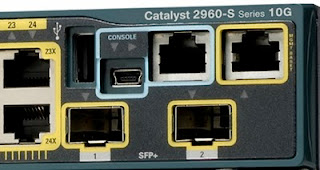
Many newer Cisco switches and routers support a USB console port in addition to the old-fashioned RJ-45 serial console port. For example, the Catalyst 2960-S switch has a mini type-B USB console port on its front plate as can be seen in the picture.
Any USB cable that has a standard type-A USB connector on one end and a mini type-B connector on the other end should work. If you wish to purchase a Cisco cable, the part number is CAB-CONSOLE-USB.
Steps for Using the USB Console Port
To use the USB console port from a Windows computer, you need to download and install a driver. Follow these instructions to do so:
- Go to the Download Software page for branch routers here: http://tools.cisco.com/support/downloads/go/Redirect.x?mdfid=282770989.
- CCO login is required. After logging in, you will be redirected to the Download Software page.
- From the Download Software page, go to Cisco 3900 Series Integrated Services Routers.
- From there go to Cisco 3945 Integrated Services Router.
- Then go to USB Console Software.
- Download the zipped file and unzip it.
- The zipped file includes a README.pdf file. Follow the instructions in the README to install the driver. For Windows XP use the Windows_32 instructions.
- Connect your USB cable from a USB port on your PC to the USB port on your router or switch. Windows automatically looks up the right driver to use.
- Launch Putty or HyperTerminal and select the right COM port for the USB port you are using. For example, on some laptops the USB port closest to the front is COM5.
- Use 9600 baud, 8 data bits, no parity, 1 stop bit, and no flow control (the usual settings for Cisco devices). NOTE: Some new switches and routers are shipping with 115200 as the default baud rate. If 9600 doesn't work, try 115200.
- Install ZTerm from here http://homepage.mac.com/dalverson/zterm/.
- Connect your USB cable from a USB port on your Mac to the USB port on your router or switch.
- Launch ZTerm. ZTerm automatically recognizes that it should use the usbmodem1 port.
- Use 9600 baud, 8 data bits, no parity, 1 stop bit, and no flow control (the usual settings for Cisco devices). NOTE: Some new switches and routers are shipping with 115200 as the default baud rate. If 9600 doesn't work, try 115200.
Console output appears on devices connected to both the RJ-45 and the USB ports. This can come in handy when two engineers wish to work on a problem together. For example, one engineer can be local with a laptop connected to USB and one engineer can be remote with a laptop coming in via Reverse Telnet through a terminal server to the RJ-45 console port. Only one engineer can input commands, however, the engineer connected via USB.
Console input is active on only one port at a time. If the USB port is in use, it takes input. A problem can occur if a user leaves a computer connected via USB. Input via RJ-45 is disabled in this case. It’s a good idea to configure a USB inactivity timeout to avoid this problem. The timeout causes USB input to be disabled if there’s no activity detected after a configurable timer. When the timer expires, the RJ-45 console becomes active.
To set the USB inactivity timeout to 30 minutes, in configuration mode, type these commands.
line console 0
usb-inactivity-timeout 30
If you need to reactivate USB input after the RJ-45 port takes over, simply disconnect and reconnect the USB cable.

The usb-inactivity-timeout command is not supported on 2900 series routers.
ReplyDeleteThis comment has been removed by the author.
ReplyDeleteI know this article has a long time, but I couldn't get out without thank you for the information. It was very helpful! Thanks!
ReplyDeleteVery useful, it really helped me. Thank you.
ReplyDeleteI know this is an old post, but it helped me and I thought I'd share the way that I use it on the Mac.
ReplyDeleteI don't actually use ZTerm, I use Terminal and the screen command. All you have to do is:
- Connect the USB cable
- Open Terminal
- Enter the command: ls /dev/tty.*
- Find the USB serial port (something like /dev/tty.usbmodemfd131)
- Enter the command: screen [USB serial port ] (for example screen /dev/tty.usbmodemfd131)
- And you're in!
Thank you for sharing this information. Those instructions are very clear for us now. Montreal Escorts Team
ReplyDeleteGreat Help... Links have changed; however, following the support links for my device I was able to locate the "USB Console Software".
ReplyDeleteCheers.
How do we get user ID? Please help me.
ReplyDeleteStill helpful. Thanks!!
ReplyDeleteIn our case, the OS chose a driver that didn't work. It looks like the port is ready to use but our terminal program (PuTTY) refused to connect. The solution was to "update" the driver and, while doing so, specifically select the Cisco driver. I confirmed this on two different PCs.
ReplyDeleteI hope that other readers will also experience how I feel after reading your article. I feel very grateful that I read this. It is very helpful and very informative and I really learned a lot from it. magnetic usb cord
ReplyDeleteNew servers are shipping with 10 Gb Ethernet on the motherboard, and the price for 10 Gb Ethernet cards has dropped so much that 1 Gb for servers is becoming difficult to cost justify. Bussmann Fuses
ReplyDelete